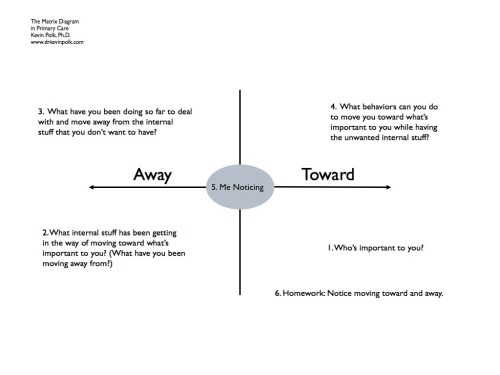She didn’t seem obviously depressed as I entered the room.
“So, we have you taking a good dose of both antidepressants now”, I said. “How are you doing?”
“I feel about the same.”
“Have you done anything lately that could have made you feel a little better?”
“I’m not sure…”
“I’ll give you some examples. They can be different things for different people. It could be reaching out to a friend, helping a neighbor, watching the sunrise…”
“I listen to music. John can tell what kind of mood I’m in depending on what I’m playing. And I watch my shows on cable TV. I feel better when I do those things.”
“Are there things in your life that are more important than music and TV?”
“Our grandkids. Our youngest daughter lives here in town and her kids really light up my life.”
“And you see them quite often, right?”
“Yes, we babysit them every weekend. You should see John with them. He’s such an awesome grandfather. It warms my heart…”
“You’ve started seeing Betty now, right? Did you notice over in the Behavioral Health wing that there is a white board that’s divided in four rectangles with a little circle in the middle?”
“Yeah, I think I’ve seen that…”
Has Betty talked with you about that yet?”
“No…”
“She probably will. It’s a great way to organize your thoughts and your feelings. It’s called ACT. Let me tell you about one aspect of it. It’s the difference between away moves and toward moves.”
She shifted a little forward in her chair.
“The bottom right is what’s really, really important to you, like your grandkids. And the bottom left is all the stuff inside your mind that keeps you away from what’s important. The top left is all the moves you make that take you away from your sadness, anxiety, pain and so on, but that don’t actually bring you closer to what’s important. We call that Away Moves, almost like escapes. That’s where music and TV might belong, unless they are in the box on the lower right. But those things don’t bring you any closer to your grandkids and the happiness they give you, right?”
“I see what you mean…”
“The horizontal line has arrows at each end. By the arrow to the left it says Away and to the right it says Toward. And in the top right rectangle are little things, steps you can take, that bring you closer to what’s important.”
“I see the difference…”
“So, other than your grandchildren, who or what else is important to you?”
“My daughters in Lewiston and Bar Harbor.”
“Anything else?”
“I don’t know…”
“You have a cross on that chain. What’s your faith?”
“I was raised Baptist. My daughter in Lewiston sings in the church choir there and I used to do that many years ago…”
“How often do yo see these two daughters? How often do you go to church?”
“Not often enough…”
“Could you do more of that?”
“I don’t think John would want to go.”
“He might, or he might want to take care of the grandkids while you do those things, right?”
“I never thought of that…”
“It sounds like you have a lot of love inside you that hasn’t been expressed often enough, and it sounds like your faith hasn’t had enough space in your life lately.”
She nodded.
“I know you as a very caring and soulful person and I think of you as someone who thrives on connecting with others. Maybe your bond with your other daughters could be a lot stronger, and maybe that would help you feel happier and less depressed. You and Betty could talk more about that in your next session…”
“I really hope we can.”
“Because there is more to treating depression than picking the right medicine”, I said.
She smiled and locked her gaze straight at me. Her eyes were moist and she smiled faintly.
[”Acceptance and Commitment Training/Therapy (ACT) is an an evidenced-based way of helping people let go of struggling and get moving toward valued living. “Traditional” ACT is complicated and hard to learn. The ACT Matrix is easy.” Dr. Kevin Polk]
https://www.theactmatrixacademy.com/












0 Responses to “The Power of ACT”